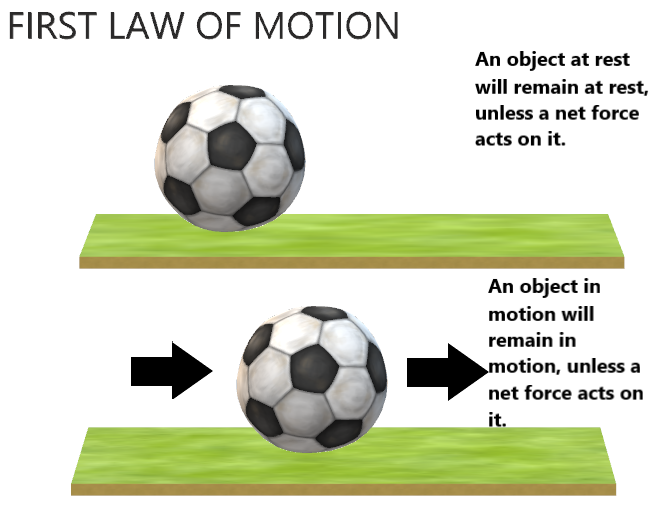在物理学中,将物体在给定时间间隔内相对于其周围环境的位置变化定义为运动。质量为m的物体的运动可以用数学术语来描述,例如距离,位移,速度,速度,时间和加速度。根据对伽利略伽利略实验的观察,牛顿提出了三个运动定律。这些定律被称为牛顿运动定律。在解释牛顿运动定律之前,首先讨论一些基本术语,例如力,力的类型,惯性,例如:
力量
它被定义为对物体的推动或拉动,在物体所作用的身体上产生加速度。力可以改变其作用的身体的速度,方向和形状。
从数学上讲,它定义为质量(m)和加速度(a)的乘积:
F =马
SI的力单位为牛顿(N) 。
主要有两种类型的力:平衡力和不平衡力。
- 平衡力:如果力彼此抵消并且它们的合力等于零,则称这些力为平衡力。
- 不平衡力:当两个相反的力作用在一个物体上时,朝一个较大的力或一个使物体运动的力的方向移动一个物体,这称为不平衡力。
惯性
一个物体抵抗其静止状态或匀速运动变化的自然趋势称为惯性。
牛顿运动定律
艾萨克·牛顿爵士提出了17世纪的三个运动定律。这些定律广泛用于经典力学领域。它们几乎在任何地方都有效。有关法律的简要说明如下。
Newton’s 1st law states that a body at rest or uniform motion will continue to be at rest or uniform motion until and unless a net external force acts on it.
Newton’s 2nd law states that the acceleration of an object as produced by a net force is directly proportional to the magnitude of the net force, in the same direction as the net force, and inversely proportional to the mass of the object.
Newton’s 3rd law states that for every action there is an equal and opposite reaction.
在本文的此处,仅正确解释了第一运动定律。该定律说明了物体的运动与作用在物体上的力之间的关系。
牛顿第一运动定律
第一运动定律指出,除非受到外部不平衡力的作用,否则身体将继续保持静止或匀速直线运动。也称为 惯性定律。

用简单的话来说,我们可以说对象不能自行开始,停止或改变方向。他们需要一些外力来引起这种变化。物体抵抗其运动或静止状态的某些变化的这种趋势称为惯性。
The first law of motion depends on the following two conditions:
- Objects at rest: If an object is in the state of rest, its velocity and acceleration are having zero magnitude. This enables the object to stay in rest.
- Objects in motion: If an object is in motion, its velocity is not equal to zero whereas acceleration is equal to zero. Therefore, the object will continue to be in uniform motion.
牛顿的第一运动定律如何在日常生活中适用?
- 快速制动车辆时,由于存在惯性,乘客将被向前抛出。惯性试图使乘客保持活动状态。这就是为什么建议您在乘车旅行时系上安全带的原因。
- 过山车使用惯性原理。它继续以相同的速度沿相同方向移动,直到轨道充当改变其方向的外力为止。
- 如果您在冰上滑冰球,最终它将停止。这是因为在冰上摩擦或碰到某些东西,例如球员的棍子或球门柱。
- 只要没有力作用,放在桌上的书就保持静止。
- 马拉松运动员由于惯性继续越过终点线几米。
- 如果快速拉动,可以从碗碟下面取下桌布。除非桌布运动产生的摩擦力太大,否则餐具将保持静止。
- 太空中的人们发现,由于缺乏重力作用,他们很难停止运动。
- 惯性使溜冰者能够以直线运动在冰上滑行。
样本问题
问题1:一个人坐在电梯中,以恒定的速度向上移动。人的体重为800N。电梯绳索立即断裂,因此电梯坠落。确定在电梯钢丝绳断裂前后,电梯地板对人施加的法向力。
解决方案:
Given that,
The weight of the person, W = 800 N.
Before the elevator’s rope broke:
When the person is in the elevator, weight acts on the person downwards. A normal force acts on the person upwards and the magnitude of the normal force is equal to the weight. Because the person is at rest in the elevator and the elevator moves at a constant speed with no acceleration, so there is no net force acting on the person.
∑F = 0
N – w = 0
N = w
N = 800 N
After the elevator’s rope broke:
The elevator and the person free fall together, where the magnitude and the direction of their acceleration(a) is equal to acceleration due to gravity(g). There is no normal force on the person.
Hence, the normal force acted by elevator’s floor to the person just before and after the elevator’s rope broke are 800 N and 0 N respectively.
问题2:保持100千克物体以10 m / s的恒定速度运动需要什么力?
解决方案:
Newton’s first law states that an object in motion tends to stay in motion unless if acted upon by a net force. This means that if friction is not present, there is no net force required to keep an object moving if it’s in motion.
A net force is only required to change an object’s motion. The 100 kg object is moving at a constant velocity i.e. there is no net force acting on the object.
So, the net force is equal to 0 N.
问题3:一个人以500英里/小时的恒定速度乘坐飞机旅行。另一个人以50英里/小时的恒定速度行驶在他们的汽车中。确定两种情况下谁的加速度都更大?
解决方案:
Since both the persons are traveling at a constant speed, the acceleration of both the persons is zero.
Thus, neither of the person experiences any acceleration.
Since the acceleration is zero, then there is no net force acting on both the persons.
问题4:电梯中的乘客的质量会向下施加110N的力。他承受了从130N的电梯地板向上的法向力。如果有的话,他以什么速度加速前进?使用g = 10 m / s 2
解决方案:
Here, the net force is equal to (130 – 120) N = 20N upwards.
To find the mass of the passenger, use the following formula:
F = mg
m = 110 N / 10 m/s2
= 11kg
Then, to find the net acceleration, use Newton’s second law.
F = ma
a = 20N /11kg
= 1.81 m/s2
问题5:1500公斤的宇宙飞船在太空真空中以600 m / s的恒定速度行驶。忽略重力,宇宙飞船上的净力是多少?
解决方案:
In a vacuum, there is no friction due to air resistance. Newton’s first law states that an object in motion stays in motion unless acted upon by a net force. Thus, the spaceship will travel at the constant speed of 600 m/s and the net force on the spaceship must be zero as acceleration is also zero.
Since,
F = ma
Therefore,
F = (1500kg)(0m/s2)
= 0 N.
问题6:球从时速50英里的火车上滚下来。忽略空气摩擦,在球撞击地面之前水平方向的速度是多少?
解决方案:
Newtons first law states than an object in motion tends to stay in motion unless acted upon by an external force.
Neglecting air friction, there is no external force to slow the ball down in the horizontal direction after it falls off the train.
The acceleration of gravity would only affect the ball in the vertical direction.
So, the horizontal speed of the ball is 50 mph.
问题7:一辆面包车在后面行驶,保龄球在后面,可以随意滚动。货车接近红灯,必须减速以使其完全停止。当货车减速时,保龄球向哪个方向滚动?
解决方案:
According to Newton’s First Law of Motion, an object that is in motion will stay in motion unless acted on by another force.
When the van slows down, the ball will want to continue moving forward, and the friction between it and the floor of the van is not strong enough to keep the ball back.
So, the bowling ball rolls to the front of van.